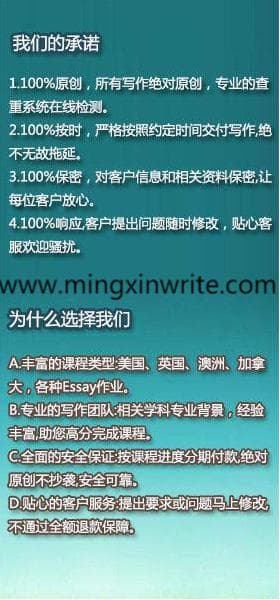发布时间:2020-12-17 热度:
我们提供英语国家如美国、加拿大、英国、澳洲、新西兰、新加坡等华人留学生论文作业代写、essay润色精修、课业辅导及网课代修代写、Quiz,Exam协助、期刊论文发表等学术服务,mingxinwrite拥有的专业写手皆是精英学识修为精湛;实战经验丰富的学哥学姐!为你解决一切学术烦恼!茫茫人海,相遇即是缘分,我们比朋友更懂你!求知的道路,有我们携手同过,保您学业无忧!
A.
Natural selection, originally proposed by C. R. Darwin, refers to the survival of the fittest and the elimination of the unwell in the struggle for survival. From the point of view of interaction between organism and environment, Darwin believed that variation, inheritance and natural selection of organisms could lead to adaptability changes of organisms.
This natural selection uses inheritance, and only when the adapter continues to reproduce can the species be sustained.
B.
Mixed heredity means that the character of the offspring is a mixture of the character of the father and the character of the mother, and the offspring of the offspring can no longer tell that it is the character of the father or the character of the mother.
Mixed inheritance and natural selection do not evolve in exactly the same way, because mixed inheritance may have little or no effect on change
C.
Mendel couldn't understand Darwin's mixed model, so he did a lot of experiments to explain the phenomenon that Darwin's mixed model could not explain, and made important conclusions. Hostility, biology shows the characteristics determined by two factors, from both parents. Second, this result is not just a mixture of two parents. When there is a relationship between the two, one of the two is in the gene. Each of them is also likely to spread.

2.
A.
The definition of recombination is to control the gene recombination of different traits in the process of reproduction.
B.
In terms of parental genetics, the genetic attributes of A are located at the upper end of the chromosome, while the genetic attributes of B and C are located at the middle and lower ends of the chromosome, and the two are closer. So B and C more likely to remain linked to each other than to A.
C.
In genetics, the location of the genetic attributes of chromosomes plays a key role, although the probability of inheritance of each genetic trait is equal when the two are assembled, and a closer location gives a better chance of simultaneous occurrence in the next generation. So B and C are more likely to maintain interconnections rather than A.
3.
A.
The genes carried traits are the entities that increase or decrease in frequency during evolution.
B.
In heredity, DNA on chromosomes will be partitioned. It is only by replicating genes that the same genes can be passed on to the next generation.
In the process of replication, the likelihood of gene mutations is small, and these mutations have the ability to recombine according to the genes of both sexes rather than a single person.
4.
A.
The production of less melanin, the risk of vitamin D deficiency is the highest (high latitude, cloud area).
Producing more melanin, the greatest risk of skin cancer (low latitude, sunny areas).
Melanin molecules absorb ultraviolet light, which protects the body from skin cancer, and sunlight can also help people produce vitamin D. So if people have too many melanin molecules that block the sun's absorption, they can't get vitamin D. Therefore, the adaptability of melanin is shown in the appropriate amount of melanin, allowing the skin to receive solar radiation at the same time, which is sufficient to produce vitamin D, maintain skin health.
B.
We can see that living at higher temperatures. People with strong sunshine will get dark skin, and people who live in less intense sunshine will get lighter skin. Because people need more melanin molecules to protect them from ultraviolet light in strong sunlight, people in less sunny places need less melanin, and they can absorb sunlight and produce vitamin D.
C.
The distribution of human skin color supports my view in 4B.
We know that people in the tropics have darker skin, like people in Africa and Asia near the equator, and people in temperate and cold regions have shallower skin, like China, the United States and Europe. The reason is that the sun is stronger in the tropics, so people need to produce more melanin to protect them from ultraviolet radiation and reduce the incidence of skin diseases. The solar radiation in temperate and frigid zones is weaker than that in low latitudes, so people need less melanin.
D.
For example people who have albinism diseases will have higher risk of skin cancer because they are lack of melanin molecule.
5.
A.
People produce more melanin in the sun, and people who live in tropical and high temperatures have darker skin. People in temperate and cold zones do not experience this condition, which means that the skin reacts differently to different kinds of solar radiation.
B.
This really supports the arguments I put forward in 4B. Because in this case, humans produce enough melanin to protect them from the sun and produce enough vitamin D.
C.
Skin irritation produces blisters.
The callus produces consistent damage after friction, and the skin produces callus for physical protection purposes. The evolutionary difference between callus and blister is that blisters are temporary symptoms and callus are long-term protective physical responses.
D.
These are two different situations. Suntanning is facultative adaptation and sunburning is susceptibility.









